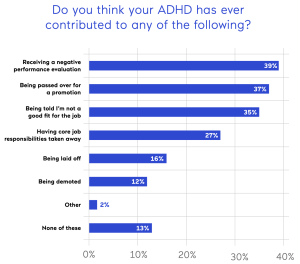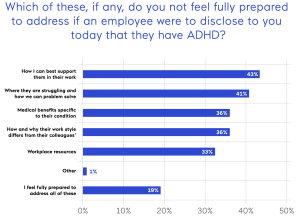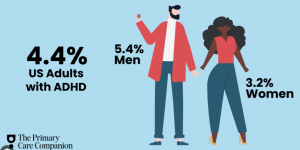It often surprises people when I tell them than Attention Deficit Hyperactivity Disorder – or ADHD as it is more commonly known – is an incredibly prevalent condition.
The condition – which affects people’s behavior, and means these people can be restless, have trouble concentrating, or may act on impulse rather than a more considered way – is estimated to impact more than 11 million adults in the United States.
In fact, growing awareness and diagnoses have risen steadily over the past few decades. Reports of adult ADHD actually rose 123% between 2007 and 2016, and some studies suggest this rate has further increased since the pandemic began.
A problem often overlooked, and misunderstood
This increase in diagnoses is itself putting pressure on those that have ADHD.
Not only are many people finding that treatment options are inadequate, but stimulant medications like Adderall or Ritalin [the current default treatment], have been in a shortage for well over a year now, with no end in sight. Just to access their medication, some people with ADHD have had to call countless pharmacies or drive for hours to find a 30-day supply – or they end up having to go without altogether.
But while awareness of ADHD may well be rising, it’s because symptoms in adults are sometimes invisible, that ADHD can easily go overlooked in the workplace – and this means it can create far-reaching implications for employees, managers, and company culture alike.
I say this as a leading researcher on ADHD. I know that the gap between the care that folks with ADHD need and what’s available to them has left people struggling. And the impact of this has bled into the workplace, leading my team at Akili to commission a study to identify the primary challenges and needs of employees with ADHD.
Lack of workplace support
What we found quite clearly was that people with ADHD are seriously struggling, and their workplaces simply aren’t equipped with the right people/processes to support them (see below)



Most employees with ADHD (87%) reported experiencing negative impacts on their career because of their condition.
But a striking 97% of workers said that would be capable of accomplishing more if they could better manage their symptoms.
In particular, our research shows employees with ADHD feel left behind and unsupported by leadership teams.
We found – quite emphatically – that for employees with ADHD to thrive, the workplace needs to rethink treatment, resources, and understanding across the board.
What can be done? How managers can help
Beyond creating specific workplace accommodations (see below), employees are typically looking to their coworkers and managers for understanding.

In our survey, more than 9 out of 10 employees (93%) said that having a supervisor who knows how to support and work with them is more valuable than any other office benefit or perk.
At the same time, we found that many managers are unsure what to do if an employee tells them they have ADHD.
More than half (59%) expressed that they wouldn’t feel completely prepared to appropriately respond if one of their employees disclosed their ADHD diagnosis.
Most managers (93%) also admitted they would have specific concerns about an employee who shares about their ADHD. This puts employees in a challenging spot: they need to talk about their diagnosis to get appropriate resources, but in doing so, they risk misconceptions and biases from their manager.
If you’re a CHRO/manager, I would say it’s okay to not know what to say right off the bat. You just need to know that employees with ADHD are just as capable as anyone else.
As a leader, lead with support and resources, and embrace employees’ unique strengths to help them thrive.
If a manager or senior leader has ADHD or is otherwise neurodivergent, it can be incredibly powerful to share that with colleagues to foster a culture of inclusivity, reduce stigma, and inspire open conversations about neurodiversity in the workplace.
Avoid short-term solutions
Employee support goes beyond the current medication crisis.
Not all people with ADHD will use any treatment, while others will turn to alternatives like cognitive treatments delivered via video games, behavioral therapy or meditation.
But data shows that regardless of treatment choice, people with ADHD need more support.
Folks who are struggling with ADHD at work are willing and eager to work with their leaders on how best to manage symptoms in order to feel more successful.
Most employees (85%) have disclosed their ADHD diagnosis to a supervisor, and the majority of them (79%) are happy with their choice.
Plus, ADHD adds a new perspective and skillset to employees, with respondents citing strengths like increased creativity (51%), ability to think outside the box (49%), and higher levels of empathy (46%).
With increased awareness comes the ability to help – through education, training, and resources – unlock the potential of a neurodiverse workforce.
Workplace accommodations for ADHD
To nurture employees with ADHD, workplaces should offer meaningful accommodations, backed up by concrete policies.
No single solution works for every employee with ADHD, but I recommend starting with some combination of the following:
- Offer distraction-free zones: It helps to have a strict “no talking” zone within the office. This space can both help folks avoid distractions and create a space that the brain associates with deep work.
- Create no-interruption periods: People with ADHD can find it hard to focus when their work day involves constantly switching between meetings, tasks, and emails. For an hour or two a day, allow employees to go on do-not-disturb mode and work without responding to messages or joining calls.
- Break large tasks into incremental deliverables. Rather than assigning one big project with a far-off due date, managers can work with their employees with ADHD to make plans for each step of the process with corresponding deadlines. Because people with ADHD can struggle with procrastination, this helps make a long assignment more manageable.
- Connect employees with resources and benefits. In and out of work, there are tools that can help people with ADHD build focus. As one example, I helped with clinical tests of EndeavorOTC – a video game app clinically designed to treat and improve ADHD symptoms for adults – to provide more options for the community. Giving employees access to tools like these, along with mental health care resources through insurance packages, can make a major difference.
Remember that not all employees with ADHD want these or any accommodations.
Rather than make assumptions, talk to each individual in order to understand their personal needs.
ADHD: The stats


Source: Psychiatric Times
* An estimated 35% to 78% of children diagnosed with ADHD maintain symptoms as an adult
* Adult ADHD is associated with a substantial economic burden, contributing an estimated $122.8 billion in total societal excess cost due to unemployment, productivity loss and health care services
* Approximately 2.6% (139.8 million) of adults worldwide have persistent ADHD from childhood, which includes individuals who experienced childhood onset paired with continued ADHD symptoms into adulthood
